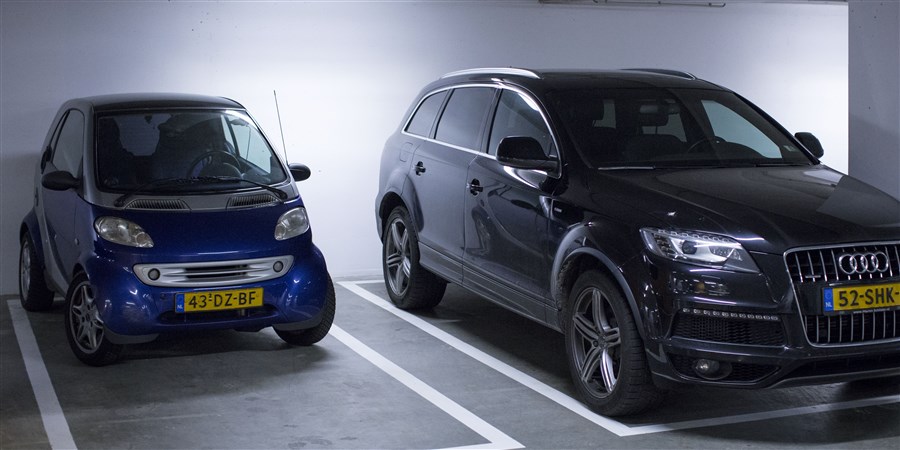Passenger cars keep getting longer, wider and heavier

New cars are heavier than older cars, on average
If only the latest model years are taken into account, the weight increase is even more noticeable. The average weight of a car built in 2024 was 1,554 kilograms, compared to 1,224 kilograms for cars built in 2016. That is an increase of 26.9 percent.| Bouwjaar | Average unladen weight (kg) |
|---|---|
| 2016 | 1224 |
| 2017 | 1228 |
| 2018 | 1247 |
| 2019 | 1312 |
| 2020 | 1395 |
| 2021 | 1448 |
| 2022 | 1463 |
| 2023 | 1504 |
| 2024 | 1554 |
Heavy electric cars are on the rise
The fact that the average weight of new passenger cars is increasing is partly due to the growth in the number of all-electric cars and plug-in hybrid electric vehicles (PHEVs). These type of PEVs are heavier, on average, than petrol-driven cars, partly because of their batteries. For cars built in 2024, a PEV weighs an average of 1,875 kilograms, while a petrol-driven car weighs an average of 1,217 kilograms.New PEVs are heavier, on average, than PEVs made a few years ago (2024 cars are 4.9 percent heavier than 2016 cars). However, the average weight of cars is increasing, mainly because the number of PEVs is growing rapidly. 4.4 percent of cars built in 2016 were PEVs, while the share for 2024 cars was 49.0 percent.
| Bouwjaar | Petrol-driven cars and hybrids (%) | Diesel cars and hybrids (%) | All-electric cars and plug-in hybrids (%) | Other (%) |
|---|---|---|---|---|
| 2016 | 83.6 | 11.6 | 4.4 | 0.4 |
| 2017 | 87.3 | 9.8 | 2.5 | 0.5 |
| 2018 | 88.0 | 6.7 | 4.9 | 0.4 |
| 2019 | 83.3 | 5.4 | 11.1 | 0.2 |
| 2020 | 68.4 | 3.8 | 27.3 | 0.5 |
| 2021 | 62.5 | 2.9 | 34.0 | 0.6 |
| 2022 | 60.5 | 2.1 | 36.8 | 0.6 |
| 2023 | 54.9 | 1.4 | 43.1 | 0.6 |
| 2024 | 49.4 | 1.1 | 49.0 | 0.6 |
Passenger cars are getting bigger
Passenger cars are not only increasing in weight, but also in length and width. Cars manufactured in 2024 were 5.0 percent longer than cars built in 2016, on average. The average length of cars built in 2024 was 441 centimetres, compared to 420 centimetres for cars produced in 2016.Cars built in 2024 were an average of 6 percent wider in size than cars made in 2016. In 2024, new cars had an average width of 182 centimetres, compared to 176 centimetres for cars built in 2016. That is an increase of 3.6 percent.
Heavier cars are usually driven further
Twenty-five percent of kilometres travelled in 2024 were driven by cars heavier than 1,500 kilograms, compared to 15 percent in 2018. This increase was partly due to the growing number of cars in this heavier weight class. In addition, heavier cars are driven further than lighter cars, on average. In 2024, the average car weighing up to 850 kilograms travelled an average of 8.7 thousand kilometres per year, while for cars weighing more than 1,500 kilograms, this was 15.9 thousand kilometres.
| Jaar | 850 kg or less (billion km) | 851-1150 kg (billion km) | 1151-1500 kg (billion km) | 1500 kg or more (billion km) |
|---|---|---|---|---|
| 2018 | 12.9 | 37.2 | 52.3 | 17.9 |
| 2019 | 12.8 | 37.1 | 52.6 | 18.7 |
| 2020 | 10.9 | 30.9 | 42.2 | 15.7 |
| 2021 | 11.3 | 31.5 | 44.1 | 18.5 |
| 2022 | 11.6 | 32.7 | 47.5 | 22.8 |
| 2023* | 11.4 | 33.3 | 48.4 | 26.5 |
| 2024* | 10.9 | 32.7 | 47.3 | 30.6 |
| * provisional figures | ||||